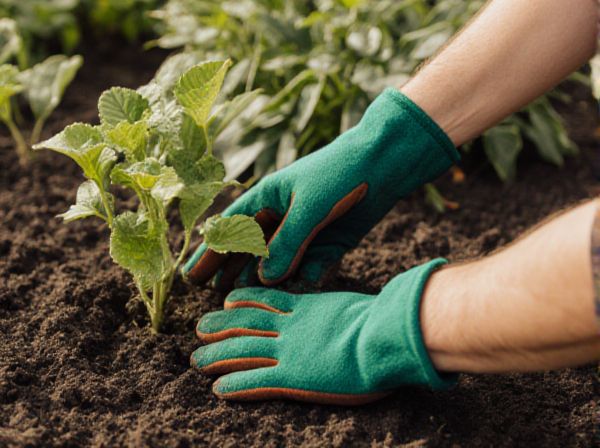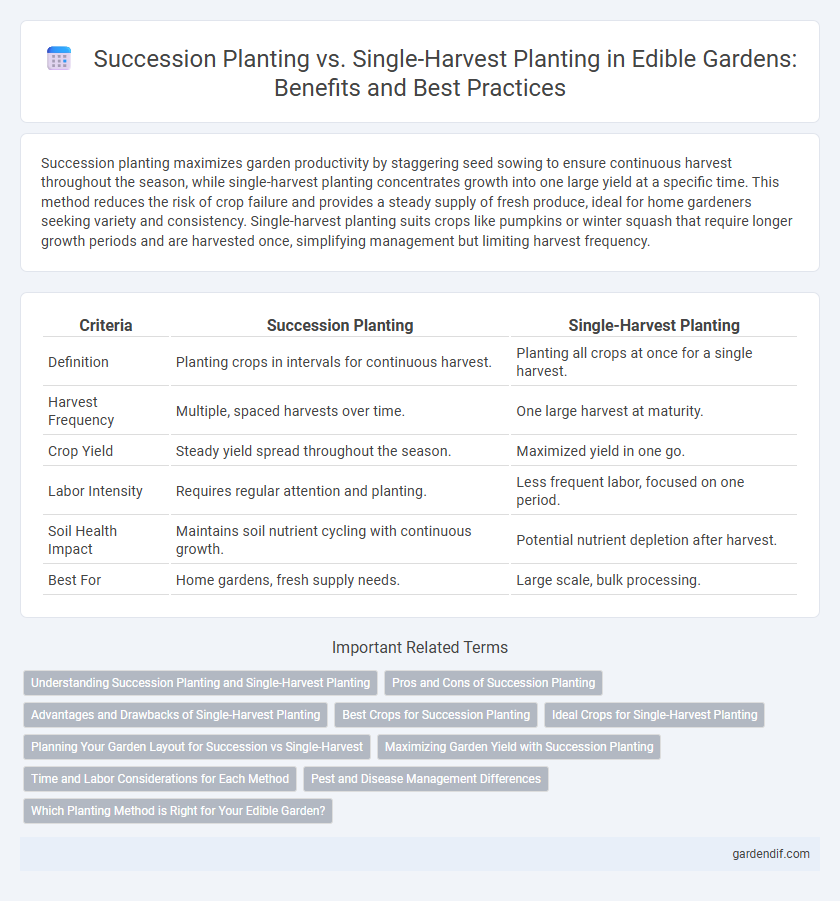
Succession planting vs single-harvest planting Illustration
Succession planting maximizes garden productivity by staggering seed sowing to ensure continuous harvest throughout the season, while single-harvest planting concentrates growth into one large yield at a specific time. This method reduces the risk of crop failure and provides a steady supply of fresh produce, ideal for home gardeners seeking variety and consistency. Single-harvest planting suits crops like pumpkins or winter squash that require longer growth periods and are harvested once, simplifying management but limiting harvest frequency.
Table of Comparison
| Criteria | Succession Planting | Single-Harvest Planting |
|---|---|---|
| Definition | Planting crops in intervals for continuous harvest. | Planting all crops at once for a single harvest. |
| Harvest Frequency | Multiple, spaced harvests over time. | One large harvest at maturity. |
| Crop Yield | Steady yield spread throughout the season. | Maximized yield in one go. |
| Labor Intensity | Requires regular attention and planting. | Less frequent labor, focused on one period. |
| Soil Health Impact | Maintains soil nutrient cycling with continuous growth. | Potential nutrient depletion after harvest. |
| Best For | Home gardens, fresh supply needs. | Large scale, bulk processing. |
Understanding Succession Planting and Single-Harvest Planting
Succession planting maximizes yield by staggering seed sowing or transplanting at intervals, ensuring continuous harvests and efficient use of garden space. Single-harvest planting involves sowing or transplanting a crop all at once, ideal for crops harvested fully at maturity like root vegetables or grains. Understanding these methods allows gardeners to optimize planting schedules, increase productivity, and better manage crop rotation for sustainable edible production.
Pros and Cons of Succession Planting
Succession planting offers continuous harvest over an extended season, maximizing garden productivity and reducing gaps in fresh produce availability. It requires careful planning and timing to avoid overcrowding and to ensure optimal crop growth stages. However, this method demands more attention and labor input, which can be challenging for novice gardeners or those with limited time.
Advantages and Drawbacks of Single-Harvest Planting
Single-harvest planting offers the advantage of concentrated crop management, allowing for efficient use of resources like water, fertilizers, and labor during a specific growing period. However, this approach can lead to a shorter harvest window, increasing vulnerability to adverse weather events and pest outbreaks that may jeopardize the entire yield. Limited continuous supply also reduces market flexibility compared to succession planting, which staggers crop maturity for ongoing harvests.
Best Crops for Succession Planting
Succession planting maximizes yield by planting crops in intervals, allowing for continuous harvests throughout the growing season, unlike single-harvest planting which yields all at once. Leafy greens such as spinach, lettuce, and kale excel in succession planting due to their fast growth and frequent harvesting ability. Root vegetables like radishes and carrots also thrive in succession planting, providing steady fresh produce while optimizing garden space.
Ideal Crops for Single-Harvest Planting
Ideal crops for single-harvest planting include root vegetables like carrots and beets, as well as grains such as wheat and corn, which mature fully in one growing season. Leafy greens like lettuce and spinach can also be grown this way when harvested before bolting to maximize quality. These crops benefit from focused nutrient management and reduce labor compared to succession planting, providing a clear, timed yield.
Planning Your Garden Layout for Succession vs Single-Harvest
Succession planting requires strategic planning to stagger crop intervals, ensuring continuous harvests and efficient use of garden space, while single-harvest planting focuses on maximizing yield from one planting cycle. Succession planting involves mapping out planting dates and selecting fast-maturing varieties to maintain a steady supply throughout the growing season. Single-harvest planting emphasizes timing and spacing for optimal growth conditions, typically suited for crops like corn or pumpkins that mature all at once.
Maximizing Garden Yield with Succession Planting
Succession planting significantly maximizes garden yield by staggering planting dates to ensure continuous harvests throughout the growing season, unlike single-harvest planting which yields all crops simultaneously. This method enhances space efficiency, reduces soil depletion, and provides a steady supply of fresh produce. Opting for succession planting allows gardeners to cultivate multiple crop cycles, increasing overall productivity and garden output.
Time and Labor Considerations for Each Method
Succession planting spreads harvest times, reducing labor spikes by providing steady, manageable workloads, while single-harvest planting demands intensive labor concentrated during one peak period. Time investment in succession planting includes ongoing soil preparation and monitoring, whereas single-harvest focuses heavily on initial planting and post-harvest processing. Choosing between these methods impacts labor allocation efficiency and can optimize harvest schedules to match workforce availability.
Pest and Disease Management Differences
Succession planting reduces pest and disease pressure by disrupting the life cycles of pests, preventing infestations from establishing and spreading, unlike single-harvest planting which creates a concentrated food source that can attract and sustain pest populations. Crop rotation and staggered plantings in succession planting promote healthier soil and diverse habitats, enhancing natural pest control and reducing disease buildup. Single-harvest planting often results in uniform crop stages that can lead to rapid disease transmission and higher vulnerability to outbreaks.
Which Planting Method is Right for Your Edible Garden?
Succession planting maximizes yield by staggering seed sowing every few weeks, ensuring a continuous harvest of vegetables like lettuce, carrots, and radishes throughout the growing season. Single-harvest planting suits crops such as corn or pumpkins that mature all at once, ideal for gardeners seeking a larger, bulk harvest for canning or freezing. Choosing the right method depends on your garden's size, desired harvest frequency, and the types of edible crops you prefer.
Succession planting vs single-harvest planting Infographic

 gardendif.com
gardendif.com